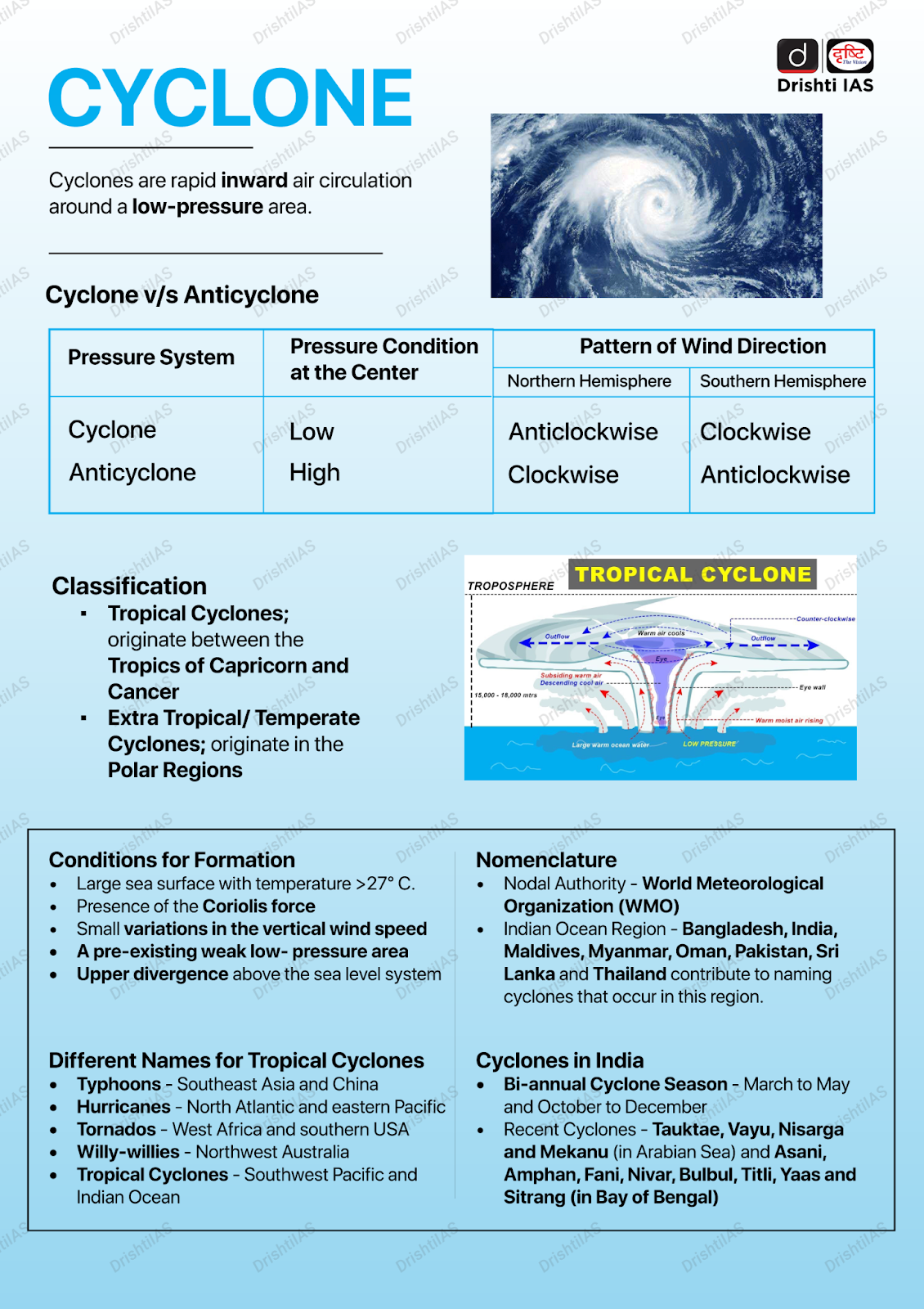Important Facts For Prelims
Typhoons in Southeast Asia
- 07 Oct 2024
- 6 min read
Why in News?
According to a study published in the journal Climate and Atmospheric Science in July 2024, typhoons are occurring frequently in Southeast Asia due to the rising global temperatures.
What are Typhoons?
- A typhoon is a form of cyclone that has wind speeds of 119 kmph and above and develops over warm ocean waters near the equator.
- When warm, moist air rises from the ocean surface, it creates a low-pressure area.
- Cyclones are rapid inward air circulation around a low-pressure area.
- The air circulates in an anticlockwise direction in the Northern hemisphere and clockwise in the Southern hemisphere.
| Cyclones Type | Location |
| Typhoon | China Sea and Pacific Ocean |
| Hurricane | West Indian islands, Caribbean Sea, Atlantic Ocean |
| Tornado | Guinea lands of West Africa, southern USA |
| Willy-willies | North-western Australia |
| Tropical Cyclone | Indian Ocean Region |
Recent Typhoons in Southeast Asia
- Typhoon Yagi: It is the strongest tropical cyclone Asia has encountered till September 2024 and the second most powerful globally after Hurricane Beryl (Atlantic Ocean).
- It has caused severe damage across Southeast Asia, affecting the Philippines, China, Laos, Myanmar, Thailand, and particularly Vietnam.
- Typhoon Shanshan: It has hit Japan bringing heavy rains and strong winds.
- Typhoon Bebinca: It has top wind speeds of 151 kph (94 mph) near its eye, and reached category 1 storm on the Saffir-Simpson Hurricane Wind Scale.
Why are Typhoons Occurring Frequently in Southeast Asia?
- Rising Sea Surface Temperatures:
- Due to global warming. Warmer waters in the Pacific Ocean provide more energy for the formation and intensification of typhoons.
- Tropical storms draw their strength from warm, moist ocean air, and the rising sea surface temperature leads to more frequent and severe storms.
- Changes in Atmospheric Circulation Patterns:
- Shifts in atmospheric circulation patterns, such as the weakening or alteration of the Walker Circulation (which influences the Pacific Ocean), can affect the frequency and trajectory of typhoons in Southeast Asia.
- El Niño and La Niña Events:
- The El Niño-Southern Oscillation (ENSO) cycle significantly impacts typhoon frequency.
- During El Niño years, the warmer waters of the central and eastern Pacific shift westward, which can increase typhoon activity in Southeast Asia.
- La Niña years also contribute to this by enhancing cyclone activity in the Western Pacific.
- The El Niño-Southern Oscillation (ENSO) cycle significantly impacts typhoon frequency.
- Increased Moisture in the Atmosphere:
- Rising global temperatures lead to more evaporation from the oceans, increasing moisture content in the atmosphere. This moisture fuels stronger and more frequent typhoons as it enhances the storm's intensity and precipitation rates.
- Geographical Location of Southeast Asia:
- The region lies in the path of the Pacific Ocean's warm currents and is a natural hotspot for typhoon formation.
- The geography of Southeast Asia, with its long coastlines and proximity to the Western Pacific, makes it highly vulnerable to tropical cyclones.
- Marine Heat Waves:
- More frequent marine heat waves, driven by climate change, are causing extreme warming events in the ocean.
- Weaker Land-Sea Temperature Differences:
- Climate change is also altering the temperature gradient between land and sea.
- Weaker differences between the land and the sea can lead to slower storm dissipation, which makes the typhoons last longer and impact areas more severely.
- Urbanisation and Environmental Degradation:
- Rapid urbanization, deforestation, and destruction of coastal ecosystems, such as mangroves, which serve as natural buffers, can exacerbate the effects of typhoons.
UPSC Civil Services Examination, Previous Year Question (PYQ)
Q. Consider the following statements: (2020)
- Jet streams occur in the Northern Hemisphere only.
- Only some cyclones develop an eye.
- The temperature inside the eye of a cyclone is nearly 10ºC lesser than that of the surroundings.
Which of the statements given above is/are correct?
(a) 1 only
(b) 2 and 3 only
(c) 2 only
(d) 1 and 3 only
Ans: (c)
Q. In the context of which of the following do some scientists suggest the use of cirrus cloud thinning technique and the injection of sulphate aerosol into stratosphere? (2019)
(a) Creating the artificial rains in some regions
(b) Reducing the frequency and intensity of tropical cyclones
(c) Reducing the adverse effects of solar wind on the Earth
(d) Reducing the global warming
Ans: (d)







